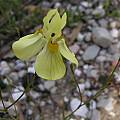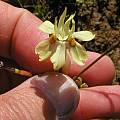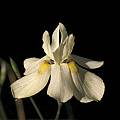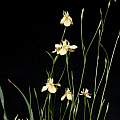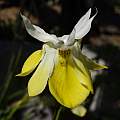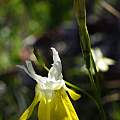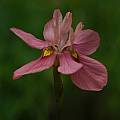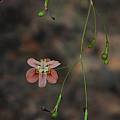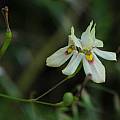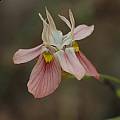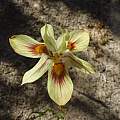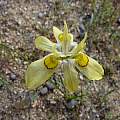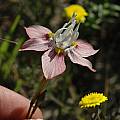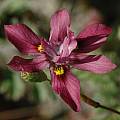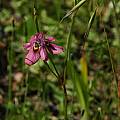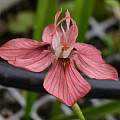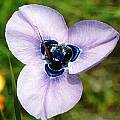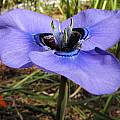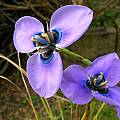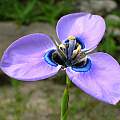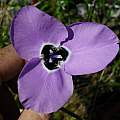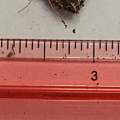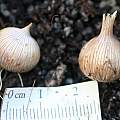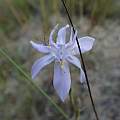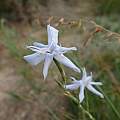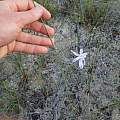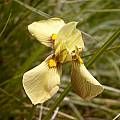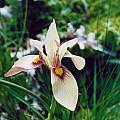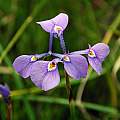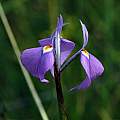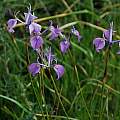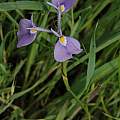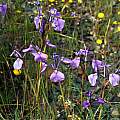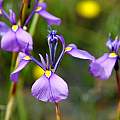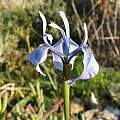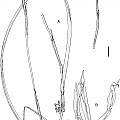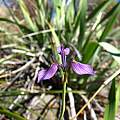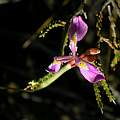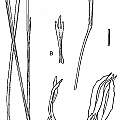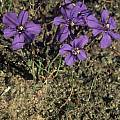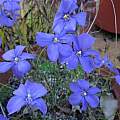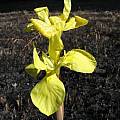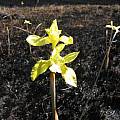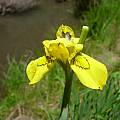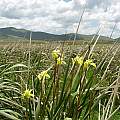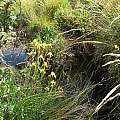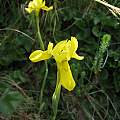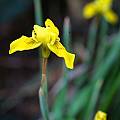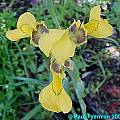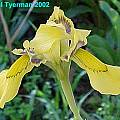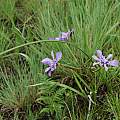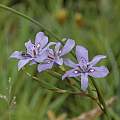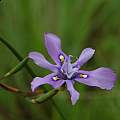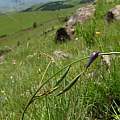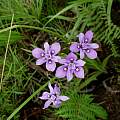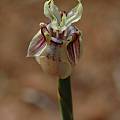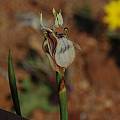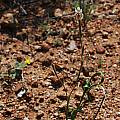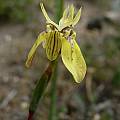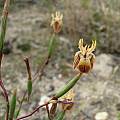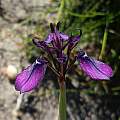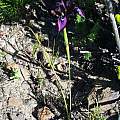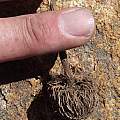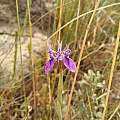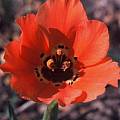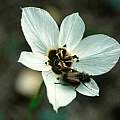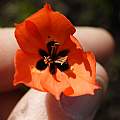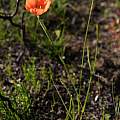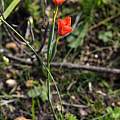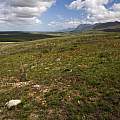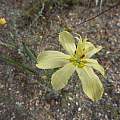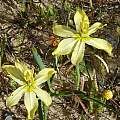The genus Moraea can be divided into five groups: Galaxia, Gynandriris, Hexaglottis, Homeria, and Moraea.
Moraea group species g-i are found on this wiki page. More information can be learned from Peter Goldblatt's book on Moraeas.
Moraea index lists all the species in all five groups alphabetically.
The other species in the Moraea group are listed alphabetically on these wiki pages: Moraea group a - Moraea group b - Moraea group c-e - Moraea group f - Moraea group j-m - Moraea group n-r - Moraea group s - Moraea group t - Moraea group u-v - Moraea hybrids
Moraea gawleri Spreng. is widespread in the Cape province and is found growing on sandy or clay slopes, usually in Renosterveld. It has linear channeled leaves and yellow, cream, or brick red small short lived flowers that appear in late winter-spring. These photos by Bob Rutemoeller were taken in September 2003 in South Africa. The first was taken in the Little Karoo and the second in Bontebok National Park and gives you an idea of the size of the flowers. The third and fourth photos are of a plant in cultivation taken by Bob Werra. The last two photos are of a bright bicolored form found in a pot of otherwise typical yellow M. gawleri. The brightly colored form is about a third larger than the typical plants, but vegetatively looks the same. Photos by Michael Mace.
The first of three photos below taken September 2006 by Mary Sue Ittner was taken near Nieuwoudtville and the second and third near Clanwilliam where they were growing along a moist bank next to the road. The fourth photograph from Bob Rutemoeller was taken at that same spot. The last two photos were taken by Cameron McMaster September 2011 near the Pakhuis Pass and in Namaqualand.
A very desirable color is the brick red form found in the West Coast near Darling. First three photos by Bob Rutemoeller and Mary Sue Ittner from September 2006. Fourth photo was taken in California by Michael Mace.
Moraea gigandra L.Bolus is a strikingly beautiful Moraea that is endangered in the wild, surviving only on a few isolated sites on steep stony slopes in heavy clay soil in the northwestern Cape. It has been easy to grow in Northern California in a raised bed, dry in summer. This species has one of the largest flowers in the genus. Peter Goldblatt's book on Moraeas reports that these plants can also be found in orange and white, but we're not aware of any photographs of them, let alone plants in cultivation. There is, though, a slight variation on the purple form, shown in the fifth photo. This flower is even larger than the usual form and has paler petals (the flower in the photograph is newly-opened and will fade in the sun). The blue nectar guide can barely be seen, but the flower has a distinct white ring around the center. Photos by Mary Sue Ittner , Bob Rutemoeller, Alan Horstmann, and Michael Mace.
Photographs of corms were taken by Michael Mace and M. Gastil-Buhl. Corms in the second photo from Telos Rare Bulbs.
Moraea gracilenta Goldblatt grows in sandy soils, usually near seeps or streams in the Western Cape and flowers September-October with the flowers opening in the late afternoon and only lasting a few hours. Growing from 12 to 80 cm high, it has one (or two) linear, channeled trailing leaves and small pale blue to white flowers in a many branched inflorescence. Photos from iNaturalist taken by Gregory Nicolson in the Western Cape in September and shared under a CC BY-NC license
Moraea graminicola Oberm. grows in open grassland in the Eastern Cape. It has a solitary leaf and yellow gray flowers. There are two subspecies. Moraea graminicola ssp. graminicola is found in KwaZulu-Natal. It has no blotches on the crests.
Moraea graminicola ssp. notata is a more southern subspecies found in the Amatola Mountains. It has dark blotches at the base of the crests. A dark mauve band from which mauve veins radiate out surrounds the deep yellow nectar guides. Photos by Cameron McMaster
Moraea grandis Goldblatt & J.C.Manning is part of the Moraea tripetela complex. Information about has been taken from the Goldblatt, Manning article describing the complex. It is restricted to the northern end of the western winter rainfall Karoo including the Bokkeveld Plateau and the Roggeveld. It is most often found in heavy red clay among rocks, but also grows on lighter soils. It has the largest flowers in the complex, pale blue to pale purple with triangular yellow or cream nectar guides on a white background, spotted and edged in dark blue. The inner tepals are hairlike, under 3.5 mm broad, the pollen orange red, and the outer tepal limbs have a comma-like tip and are oriented almost vertically in fully open fragrant flowers. It is very similar to Moraea amabilis, but the flowers are much larger and the tepals are often about as long as wide. It typically grows in colonies, expanding vegetatively and flowers from August to September. Photos below were taken near Nieuwoudtville in the Bokkeveld Plateau by Mary Sue Ittner and Bob Rutemoeller and near Calvinia in the Roggeveld September 2006.
Moraea hainebachiana Goldblatt & J.C.Manning is part of the Moraea tripetela complex. Information about has been taken from the Goldblatt, Manning article describing the complex. This species is endemic to the Saldanha District in the western Cape where it is found in rocky, limestone flats and slopes and calcareous sands. A short member of the complex at 18-28 cm, it is distinctive in having a foliage leaf that is always inserted on the stem well above the top of the cataphyll. It has pale violet to deep blue flowers; the nectar guides have dark lines and dots on a diffuse white background, with dark lines radiating onto the tepals. The inner tepals are 5–6 mm long and unusual in being expanded in the middle. The anthers are pale grey-blue and contain whitish or yellow pollen. Another unusual feature is the cluster of small, dark grey or bluish cormlets in the foliage leaf axil and at the base of the corm. It apparently does not set seed, but reproduces vegetatively. It flowers mid August to September. Photo from iNaturalist taken by kooscl late August in the Western Cape and shared under a CC BY-NC license. Drawing by John Manning shared with his permission from the paper referenced above. Figure notes: A, flowering stems and corm; B, inner perianth whorl plus filaments and style. Scale bar: 10 mm.
Moraea helmei Goldblatt & J.C.Manning is part of the Moraea tripetela complex. Information about has been taken from the Goldblatt, Manning article describing the complex. It is known from only two sites in the Kamiesberg at an altitude of 1,125 m in central Namaqualand. Growing 25-35 cm, it has pale blue to violet flowers with a yellow nectar guide outlined in light or dark blue. The outer tepals have dark veins on them and the inner tepals are distinctive with three straight tines, like a fork. Another unusual feature are tooth-like projections just below the apices on the outer tepal claws. Pollen is yellow. This species flowers late October to mid-November. Photos from iNaturalist taken by Nick Helme in October in the Kamiesberg and shared under a CC BY-NC license. Drawing by John Manning shared with his permission from the paper referenced above. Figure notes: A, flowering stem and corm; B, inner tepal; C, inner perianth whorl plus filaments and style. Scale bar: A, 10 mm; B, C, 2 mm.
Moraea herrei (L.Bolus) Goldblatt, syn. Barnardiella spiralis, was once considered the lone species of Barnardiella. It is now included in the Moraea subgroup. It has purple spreading flowers with rounded tips. It flowers in spring and is found in Namaqualand. First photo by Rod Saunders. Other photos by Gordon Summerfield.
Moraea hiemalis Goldblatt is found in open grassland at 1000 to 2000 m in KwaZulu-Natal. It has a solitary round leaf with inrolled margins and yellow flowers with dark veins and deeper yellow nectar guides. Photos by Rogan Roth who wrote: "I was delighted to come across a small colony of this rare plant flowering in the depths of winter beside a pine plantation in the Drakensberg in KwaZulu-Natal. The rich golden colour of the flowers is very striking set against the drab wintery landscape. Sadly this site has now been destroyed by logging!"
Moraea huttonii (Baker) Oberm. is a summer rainfall species that blooms in early spring where it grows in prolific clumps on the banks of mountain streams. It occurs from the Amatola Mountains in the south, along the Drakensberg Mountains in KwaZulu-Natal and into southern Mpumalanga. It has a branched stem which sets it apart from the other yellow summer rainfall species. It is large with a flowering stem about 80 cm tall and a leaf that can reach 150 cm long. Scented flowers are a clear bright yellow with yellow-brown nectar guides and darker veins on the outer tepals. The first four photos were taken by Cameron McMaster in the Eastern Cape (Elandsberg, Tiffindell, and Andriesberg). The last from Mary Sue Ittner was taken in the Eastern Cape in September where it was growing so close to the river that the soil most surely remained moist year round which no doubt explained why it was doing well since it was late winter and very dry in that area during that time of the year.
The photos below were taken by Paul Tyerman. He writes: "This very iris-like moraea is evergreen for me. Flowers are held on rigidly upright stems and make an interesting display in late October."
Moraea hybrids in this group can be found on the Moraea hybrids wiki page.
Moraea inclinata Goldblatt grows in damp grassland in the Natal Midlands and the Drakensberg mountains in KwaZulu-Natal and in the northeastern Transkei. It has a long slender stem with a single leaf inserted well above the ground near the stem apex. The large blue-violet flowers with yellow nectar guides have reflexed limbs. It flowers in summer with plants on lower elevations flowering earlier. Photos taken by Mary Sue Ittner, Bob Rutemoeller, and Cameron McMaster at Satansnek Pass in the Eastern Cape in January.
Moraea inconspicua Goldblatt is widespread in the Cape and found on sandy and clay slopes flowering in spring. It has two or three linear leaves and tiny yellow to brown or cream flowers with reflexed outer tepals. Photographs taken by Bob Rutemoeller and Mary Sue Ittner in Namaqualand September 2006 and by Cameron McMaster near Napier in the Overberg.
Moraea incurva G.J.Lewis is a winter-growing species native to a small area near Tulbagh. It grows in heavy gravelly-clay soil among loose smooth stones and has a single smooth linear leaf. The flowers are varying shades of violet with conspicuous cream nectar guides on the outer tepals. It looks a bit like Moraea tripetala but has distinctive incurving broad limbs to its inner tepals. Photos from iNaturalist taken in the western Cape by Chris Vynbos in November and Brian du Preez in October and shared under a CC BY-SA license.
Moraea insolens Goldblatt is a rare species known only from three small populations in the Overberg where it grows on clay slopes in renosterveld. It flowers well only after a fire or when vegetation around it has been cleared. It is a beautiful species that grows from 20 to 35 cm high and has deep orange or cream flowers with a brown center. Flowers are different from many Moraea subgroup species, looking more like a Homeria subgroup flower with the tepal claws broad and spreading. First photo by Rod Saunders. The second photo by Colin Paterson-Jones shows the cream form, with a monkey beetle on it.
The photos below by Michael Mace were taken at the second known site for the species, a private renosterveld reserve near Stanford. The flowers were scattered at the top of a low slope among Wachendorfia paniculata. The overlying brush here had been burned the previous autumn. A couple of dozen M. insolens plants bloomed here in 2016. Here are four views of the flowers, followed by a photo of the spot where they grow.
Moraea intermedia Goldblatt & J.C. Manning described by Goldblatt and Manning in 2010 is a rare species found in open sandy places among granite outcrops in Namaqualand near Springbok. It is a member of the small section Tubiflora. Photos taken in Namaqualand by Cameron McMaster September 2011.
Galaxia - Gynandriris - Hexaglottis - Homeria a-j - Homeria k-z - The other species in the Moraea group are listed alphabetically on these wiki pages: Moraea group a - Moraea group b - Moraea group c-e - Moraea group f - Moraea group j-m - Moraea group n-r - Moraea group s - Moraea group t - Moraea group u-v - Moraea hybrids - Moraea index
